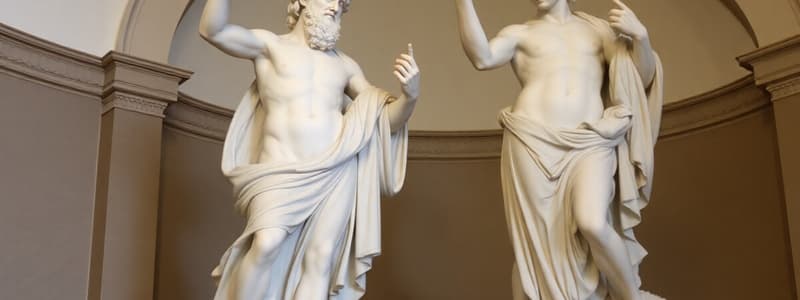Podcast
Questions and Answers
Welke techniek gebruikte Michelangelo om beweging en emotie in zijn sculpturen te tonen?
Welke techniek gebruikte Michelangelo om beweging en emotie in zijn sculpturen te tonen?
- Chiaroscuro
- Contrapposto (correct)
- Fresco
- Sfumato
Welke van de volgende sculpturen is een beroemd werk van Michelangelo?
Welke van de volgende sculpturen is een beroemd werk van Michelangelo?
- De Zoon van Man
- De Denkende Man
- De Stervende Slavin (correct)
- Pietà (correct)
Wat was een belangrijk kenmerk van Michelangelo's aanpak bij het snijden van marmer?
Wat was een belangrijk kenmerk van Michelangelo's aanpak bij het snijden van marmer?
- Meticuleuze en subtractieve aanpak (correct)
- Directe vorming zonder voorbereiding
- Toepassing van een hybride techniek
- Gebruik van simultaantechnieken
Welk architectonisch meesterwerk heeft Michelangelo ontworpen en de bouw ervan overwogen?
Welk architectonisch meesterwerk heeft Michelangelo ontworpen en de bouw ervan overwogen?
Welke van de volgende stellingen over Michelangelo's invloed op de Renaissance is waar?
Welke van de volgende stellingen over Michelangelo's invloed op de Renaissance is waar?
Wat was de reactie van Michelangelo's vader op zijn artistieke ambities?
Wat was de reactie van Michelangelo's vader op zijn artistieke ambities?
Welke elementen zijn kenmerkend voor Michelangelo's sculptuurtechnieken?
Welke elementen zijn kenmerkend voor Michelangelo's sculptuurtechnieken?
Welk aspect van Michelangelo's werken toont zijn diepgaande begrip van menselijke emotie?
Welk aspect van Michelangelo's werken toont zijn diepgaande begrip van menselijke emotie?
Flashcards
Michelangelo's Sculptuurtechnieken
Michelangelo's Sculptuurtechnieken
Michelangelo gebruikte verschillende technieken, waaronder chiaroscuro (contrast van licht en schaduw) en contrapposto (een natuurlijke houding gebalanceerd op één been) om vorm, beweging en emotie weer te geven.
Michelangelo's Bekendste Kunstwerken
Michelangelo's Bekendste Kunstwerken
Bekende werken zijn onder andere David, Pietà, Mozes en De stervende en de opstandige slaaf.
Michelangelo's Architectuurbijdragen
Michelangelo's Architectuurbijdragen
Michelangelo ontwierp en controleerde de bouw van delen van de Sint-Pietersbasiliek in Rome.
Renaissance Invloed van Michelangelo
Renaissance Invloed van Michelangelo
Signup and view all the flashcards
Michelangelo's vroege leven
Michelangelo's vroege leven
Signup and view all the flashcards
Chiaroscuro
Chiaroscuro
Signup and view all the flashcards
Contrapposto
Contrapposto
Signup and view all the flashcards
Anatomiestudie Michelangelo
Anatomiestudie Michelangelo
Signup and view all the flashcards
Study Notes
Michelangelo's Sculpture Techniques
- Michelangelo employed a variety of techniques in his sculptures, including chiaroscuro (contrast of light and shadow) to model forms, and contrapposto (a natural pose balanced on one leg) to convey movement and emotion.
- He meticulously studied anatomy, accurately depicting the human form in his sculptures.
- His mastery of carving marble, a notoriously difficult material, is evident in his works. He employed various tools, including hammers, chisels, and mallets, to shape and refine the stone.
- He often favoured a meticulous and subtractive approach, carefully removing material to reveal the intended form.
- His approach involved careful planning and preparation, including the use of preliminary sketches and models.
Michelangelo's Famous Artworks
- David: A colossal marble statue of the biblical hero, David, known for its powerful physique and emotional intensity.
- Pietà: A moving depiction of Mary cradling the dead Christ, notable for its emotional depth and exquisite detail.
- Moses: A powerful figure of the prophet Moses, characterized by its monumental scale and intense expression.
- The Dying Slave: Evokes the anguish and suffering of the enslaved, revealing a profound understanding of human emotion.
- The Rebellious Slave: Another dramatic depiction of human struggle and turmoil.
Michelangelo's Architectural Contributions
- Michelangelo designed and oversaw the construction of parts of St. Peter's Basilica in Rome, a significant accomplishment in Renaissance architecture.
- He contributed to the design of the dome, though its final realization was completed after his death.
- His work in St. Peter's Basilica showcases his mastery of monumental architecture.
Michelangelo's Renaissance Influence
- Michelangelo significantly impacted Renaissance art, particularly sculpture and architecture, pushing the boundaries of artistic expression.
- His mastery of human anatomy and emotion had a profound influence on subsequent generations of artists.
- His works inspired a commitment to realism and humanism across artistic subjects.
Michelangelo's Biography and Early Life
- Michelangelo di Lodovico Buonarroti Simoni, born in 1475 in Caprese, Italy.
- His father, a government official, initially disapproved of his artistic aspirations.
- He apprenticed with the Florentine painter Domenico Ghirlandaio.
- He was exposed to humanism and classical ideals while learning the craft in Florence under the influence of the Medici family.
- He learned under other masters focusing on sculpting and painting.
- He studied human anatomy extensively.
- He was a multifaceted artist working as a sculptor, painter, architect, and poet.
Studying That Suits You
Use AI to generate personalized quizzes and flashcards to suit your learning preferences.
Description
Ontdek de technieken die Michelangelo gebruikte in zijn beroemde sculpturen. Van chiaroscuro tot contrapposto, zijn meesterlijke beheersing van marmer komt tot uiting in werken zoals David en Pietà. Test je kennis over zijn unieke aanpak en de voorbereiding die nodig was voor deze iconische kunstwerken.




